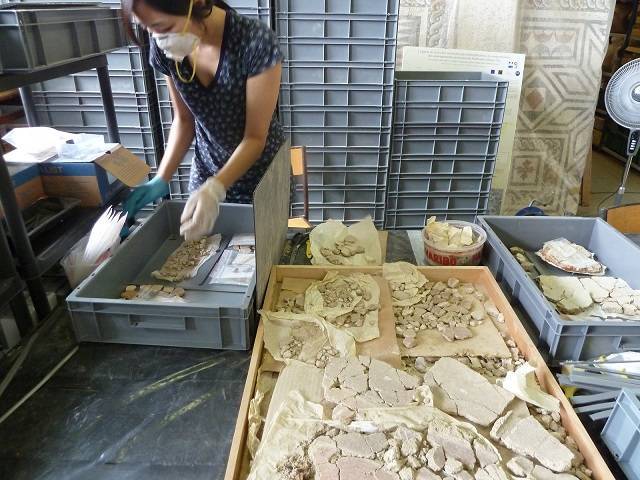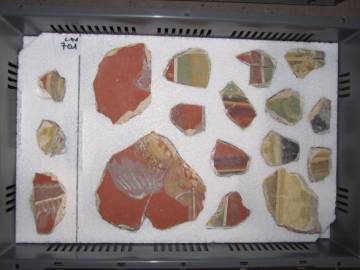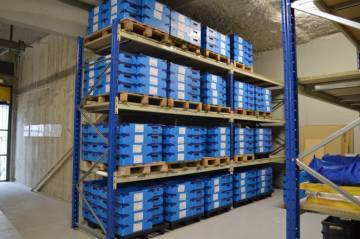La conservation du patrimoine archéologique mobilier
Les objets prélevés sur les chantiers de fouilles archéologiques sont appelés « vestiges mobiliers » ou « biens archéologiques mobiliers ». Ils doivent être conservés avec soin. C’est en les étudiant, parfois pendant de longues années, que les chercheurs pourront retracer l’histoire des hommes.
La conservation préventive
Sortis de terre, de l’eau, d’une grotte où ils se trouvaient parfois depuis des milliers d'années, les objets archéologiques peuvent s'abîmer en quelques heures. Ils sont soudain exposés à la sécheresse ou à l’humidité, à la chaleur ou au froid, à la lumière ou à la pollution. Cela peut les détruire.
Pour les garder en bon état, il faut :
- prendre des précautions en les ramassant (ne pas disperser les tessons d'une poterie, par exemple, et les numéroter) ;
- leur accorder des soins adaptés pendant qu'on les étudie (ne pas laisser se dessécher un objet en bois qu'on a trouvé dans l'eau, par exemple) ;
- les stocker dans de bonnes conditions (bien ranger les enduits peints dans une boîte spéciale, par exemple).
C'est ce qu’on appelle la « conservation préventive ».
La conservation des vestiges mobiliers se prépare dès la programmation de l'opération archéologique. Elle est mise en pratique durant toute l’opération et se poursuit dans les lieux où les objets sont déposés : les dépôts, les centres de conservation et d’étude, et les musées.
Des méthodes, des traitements, des contenants... Comment mieux conserver le mobilier archéologique ?
L’archéologue identifie les objets et les matériaux les plus sensibles. Il détermine quelles précautions il faut prendre pour maintenir les vestiges en état d’être étudiés puis conservés sur la durée. Il peut faire appel au conservateur-restaurateur en archéologie, qui est spécialisé dans la conservation préventive et la restauration des vestiges archéologiques.
Le conservateur-restaurateur en archéologie peut agir sur le terrain pendant les opérations archéologiques pour faire des prélèvements délicats (une céramique en terre crue en terrain humide, un verre éclaté en une multitude de fragments, une mosaïque antique ou un pavement médiéval, des fresques effondrées sur le sol...).
Il intervient aussi une fois la fouille achevée en apportant des informations essentielles pour la compréhension et la restitution de certains objets tellement dégradés qu’on ne peut plus les identifier. Il les fait « parler » pour retrouver leur passé et interpréter le contexte dans lequel il ont été trouvés. Par exemple, dans un amas de rouille il peut déceler un bijou, une arme, un vase en métal, un outil, avec ses décors et des éléments fabriqués dans d’autres matériaux comme le cuir, le bois ou du textile. En analysant les micro-dépôts prélevés au fond d’un récipient, on peut retracer la composition de la boisson qu’il contenait.
Le conservateur-restaurateur préserve les objets les plus fragiles en réalisant des boîtes et des supports adaptés. Il effectue également des expertises pour la conservation préventive et la restauration des vestiges sur le long terme dans un dépôt, un centre de conservation et d’étude ou un musée.
Mieux conserver pour mieux étudier : la conservation sélective
Des mesures de sélection peuvent intervenir à chaque étape d’une opération archéologique (prescription, intervention sur le terrain, remise des vestiges à l’État et stockage définitif). Elles permettront d’évaluer l’intérêt scientifique de la conservation de certains biens.
Trier pour mieux conserver. Consultez nos fiches pratiques
La conservation pérenne et la politique des centres de conservation et d’étude
Le ministère de la Culture conduit sur l’ensemble du territoire national une politique de création de centres de conservation et d’étude, afin de rassembler les vestiges mobiliers et la documentation archéologique pour un territoire qui peut aller de la commune ou de la métropole jusqu’au département ou à la région.
Les centres de conservation et d’étude accueillent les vestiges dont la conservation pérenne est nécessaire :
- ils assurent une conservation préventive performante ;
- ils garantissent aux chercheurs et aux étudiants un accès facilité à la documentation et aux objets pour la poursuite des études qu'ils ont entamées, la réalisation de nouvelles recherches, et la publication de leurs résultats ;
- ils gèrent les vestiges archéologiques mobiliers (prêt, stockage...) ;
- ils réalisent des actions de médiation à destination du public.
Portée par les collectivités territoriales, par l’État ou par un partenariat, la construction d’un centre de conservation et d’étude doit répondre à un cahier des charges garantissant la conservation des vestiges.
Le centre de conservation et d'études : bien le concevoir, bien le construire
Aide-mémoire technique. Projet de centre de conservation et d'étude
Partager la page


